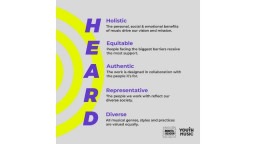What do I need to know about inclusion? HEARD Model
What is it?
An approach to music teaching and learning, as well as organisational development, that means all children and young people can take part in music-making and learning, whatever their background or circumstances.
It’s about creating access to music-making in the first place, and providing the right support and opportunities so that young people can progress on their individual journey. And it’s about music leaders having the right skills and resources to help each young person fulfil their potential.
When we talk about ‘music-making’ or ‘music-making opportunities’ we mean all the ways that young people make and learn music, in and out of schools.
So who's missing out then?
Many children and young people face barriers to accessing music-making. These can be obvious but many are not. Barriers come about because of the way society is organised and resourced. It’s our responsibility to get rid of them.
OK, so how you make music teaching and learning more inclusive then?
An easy way to understand this is that inclusive music is music that is HEARD:
Holistic - placing emphasis on personal, social and musical outcomes
Equitable – people facing the biggest barriers receive the most support
Authentic - developed with and informed by the people we do it for
Representative – the people we work with as participants and colleagues reflect our diverse society
Diverse – all musical genres, styles, practices are valued equally

Why isn't musical inclusion happening already?
It is, but it varies from place to place. Some organisations are good at ensuring access to every style and genre of music. Others excel at breaking down barriers through strategy and innovation. Others focus on training music leaders to have the right skills and resources to address any barriers and help each young person fulfil their potential. These are just a few examples. So inclusion isn't a 'destination': it's a journey. Music services, music education hubs, community and youth music organisations are all taking different routes to inclusion and are at different points on that journey.
I’m in, what do I need to do?
Here are three things you can do straight away:
- Fill in our easy-to-use Equality Diversity and Inclusion self-assessment tool and use your results to develop an EDI action plan, to refine an existing plan, or to feed into business planning
- Use the resources in the Inclusion Resource Hub section of our website to help with your inclusion work.
- Contact an Alliance for a Musically Inclusive England founder to see how they can help.
